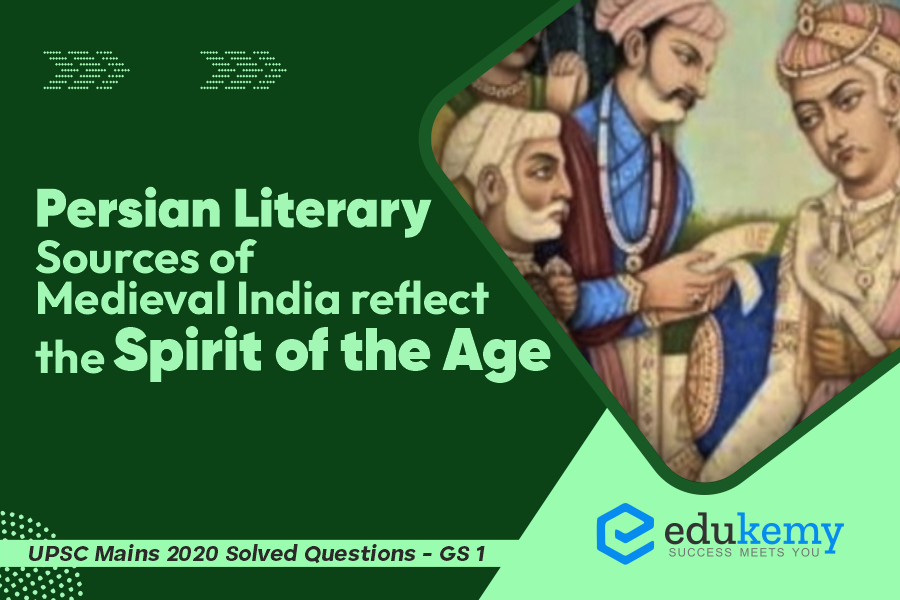The Persian literary sources of medieval India serve as a rich tapestry that vividly reflects the spirit of the age. During this period, which spanned roughly from the 13th to the 18th century, Persian became the language of administration and culture under various Islamic dynasties such as the Delhi Sultanate and the Mughal Empire. The literary works composed in Persian not only mirrored the political and social dynamics of the time but also encapsulated the cultural synthesis that emerged from the confluence of Persian, Indian, and Central Asian influences. Persian poetry, in particular, flourished, producing timeless masterpieces that explored themes of love, mysticism, and the transient nature of life. Prominent poets like Amir Khusrau and Mir Taqi Mir left an indelible mark on the literary landscape, capturing the ethos of medieval India with eloquence and grace. These Persian sources offer a window into the complex interplay of traditions, providing insights into the courtly life, Sufi mysticism, and the diverse cultural amalgamation that defined the medieval Indian subcontinent.
UPSC Mains General Studies Paper – 1 Mains 2020
The salient aspects of Art Forms, literature, and Architecture from ancient to modern times
UPSC Mains Civil Services IAS Exam Question Paper – 2020
Contents
- 1 Structure of the Question
- 2 Answer
- 3 Conclusion
- 4 Frequently Asked Questions (FAQs)
- 4.1 Q: What role did Persian literary sources play in shaping the cultural and intellectual landscape of medieval India?
- 4.2 Q: How did Persian poetry contribute to the expression of the socio-political ethos in medieval India?
- 4.3 Q: In what ways did Persian literary sources serve as a source of historical documentation for medieval India?
- 4.4 Q: How did Sufi literature in Persian contribute to the spiritual and mystical dimensions of medieval Indian society?
- 4.5 Q: In what ways did Persian literary sources contribute to the development of a cosmopolitan intellectual environment in medieval India?
- 5 In case you still have your doubts, contact us on 9811333901.
Structure of the Question
- In Introduction,
- Write briefly about Persian language advent in Indian subcontinent.
- In Body,
- Write about the various Persian literary sources of medieval India.
- Show how this literature reflects the spirit of the age, including the thought, social structure, culture, and political institutions.
- In Conclusion, you write quotes suitable to intermingling culture and people.
Answer
Introduction
Persian literary sources of medieval India reflect thought, social structure, culture, political institutions of that time or the spirit of the age. Persian was the favorite language of rulers, the Delhi Sultanate and Mughals promoted it. That was the time when Persian poetry, literature and chronicles enjoyed patronage.
Persian littérateurs and literary sources reflecting the spirit of the age
- Amir Khusrau is credited with prominent workslike Panch Ganj, Matla-ul-Anwar, Shirin wa Khuarav, Laila wa Majnun, Aina-i-Sikandari and Hasht Bihisht.He, for the first time, made use of Hindi words and idioms and wrote on Indian themes.In his ghazals, he employed alternate hem-stitches in Persian and Hindi.
- Qiran-us-Sa’dain, Miftah-ul-Futuh, Tughluq Nama, Khazain-ul-Futuh gave a record of the tactical accomplishment of Jalaluddin Khalji, Ghiyasuddin Tughluq’s ascent to power, and Alauddin Khalji’s success of the South separately.
- Minhas-us-Siraj, Ziauddin Barani, and Ibn Batuta, the renowned history specialists, wrote in Persian to illuminate about rulers and fundamental political scenes.
- Philosophy of Divinity in human beings: The Sufi literature which was in Persian developed a new form called the Malfuzat that was in the form of a dialogue of the Sufi saints. Example: Fawaid-ul Fu’ad written by Amir Hassan Sijzi. The sufi literature reflects ideas of Ruh(soul), Divine Proximity (Qurbat) and Hulul.
- Abu’l-Fazl, the author of the Akbar Nama, was a dynamic arguer and liberated thinker who constantly opposed the views of the conservative ulama and promoted the concept of questioning and liberal thinking.
- Shams Siraj Afif wrote Takih-Firoz Shahi which is of immense value to understand the reign of Firoz Shah Tughlaq (14th century).
- Khawaja Najm-ud-Din Hasan wrote Fawaid-ul-Faud which records a conversation with the great saint Nizamud-Din Aulia. This work is considered a valuable document on Sufi philosophy because it contains the discourses of Nizamud-Din Aulia in chronological order.
- Dara Shikoh, son of Mughal Emperor Shahjahan, has been credited with translating many Hindu scriptures from Sanskrit to Persian. Sirr-i-Akbar is the Persian translation of Upanishads which he completed in 1657.Dara tried to find commonalities between Hindu and Islamic traditions. He also translated Bhagavad Gita into the Persian language.

South India:
Persian literature in the south received patronage from the Adil Shahi rulers of Bijapur and the Qutab Shahis of Golconda. Muhammad Hussain Tabrezi, Malik Qummi and Mulla Zuhuri were regarded as important Persian poets. This development gave the new feature of Urdu language integrated with the local language called Daskshini (Deccan) Urdu.
Growth of regional language:
The development of Persian literature in the Mughal court played an important role and influenced the development and growth of regional literature. Languages like Punjabi, Pushtu, Sindhi and Kashmiri were strongly influenced by Persian.
Sufism and Poetry:
Amir Khusrau and Mohammad Jayasi incorporated Bhakti and Sufi tendencies of their age in their literary works
Conclusion
With the coming of the Muslims to the subcontinent, Persian, an Aryan tongue and sister language of Sanskrit, came to India, which is the confluence of diverse faiths, languages and cultures and which has a tradition of adopting and blending and then producing a composite cultural unity in diversity. But it is noteworthy that Persian learning attracted both Hindus and Muslims all over the country.
This according to Sherwani “was a symbol of the general trend of the cultural goodwill which existed in the country.”
Frequently Asked Questions (FAQs)
Q: What role did Persian literary sources play in shaping the cultural and intellectual landscape of medieval India?
A: Persian literary sources in medieval India served as a significant cultural bridge, reflecting the synthesis of indigenous Indian traditions and the influence of Persian language and literature. These sources contributed to the formation of a unique Indo-Persian literary and intellectual tradition that captured the spirit of the age.
Q: How did Persian poetry contribute to the expression of the socio-political ethos in medieval India?
A: Persian poetry in medieval India, notably through works like the masnavis and ghazals, became a powerful medium for expressing the complex socio-political dynamics of the time. Poets often used allegorical language to comment on the rulers, societal norms, and the broader cultural milieu, offering a nuanced perspective on the spirit of the age.
Q: In what ways did Persian literary sources serve as a source of historical documentation for medieval India?
A: Persian chronicles and historical writings in medieval India provided invaluable insights into the political events, court intrigues, and societal changes of the era. These literary sources not only chronicled the reigns of various rulers but also shed light on the cultural exchanges and intellectual developments that characterized the medieval period.
Q: How did Sufi literature in Persian contribute to the spiritual and mystical dimensions of medieval Indian society?
A: Persian Sufi literature played a vital role in shaping the spiritual landscape of medieval India. Sufi poets and mystics, through their poetry and prose, conveyed profound spiritual insights, emphasizing love, unity, and the quest for divine knowledge. These works not only influenced religious thought but also contributed to the synthesis of diverse cultural elements in the region.
Q: In what ways did Persian literary sources contribute to the development of a cosmopolitan intellectual environment in medieval India?
A: Persian was not only the language of the ruling elite but also a medium of intellectual exchange in medieval India. Persian literary works, including philosophical treatises and scientific writings, facilitated the transfer of knowledge across linguistic and cultural boundaries. This cosmopolitan intellectual environment reflected the inclusive and eclectic spirit of the age, fostering a rich tapestry of ideas and innovations.

In case you still have your doubts, contact us on 9811333901.
For UPSC Prelims Resources, Click here
For Daily Updates and Study Material:
Join our Telegram Channel – Edukemy for IAS
- 1. Learn through Videos – here
- 2. Be Exam Ready by Practicing Daily MCQs – here
- 3. Daily Newsletter – Get all your Current Affairs Covered – here
- 4. Mains Answer Writing Practice – here


